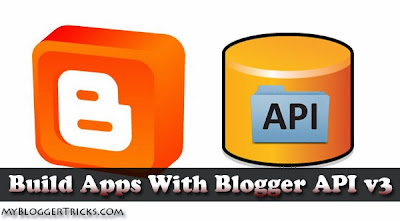
Do you like to blog? get the amazing Google Blogger API. It is used to create good Blogger Client Applications of your own! Apps builder allows external applications to update and it can also view Blogger Content. Your client apps can also use Blogger API v3 to create a new post on your Blog. It also help to edit or delete existing posts, and queries. it can also be use to create desktop and mobile act.
Tips about Blogger API and how it can help you
An
Application Package Interface ( API ) is a set of commands you can
interface, or call with, from an external application. It helps a
developer of an app to provide APIs if they want others (developer) to
create application and interact with their own,
What API can do:
- It helps to add pages, post and comments from your blog to a non-blogger website
- It can also Create desktop software that will allow users Edit or create post to their blog from their desktop computer.
- It can also Create browser and mobile-based apps. This apps can serve the same purpose as above.
Basics
Lets know some objects and resources available in the API . There are five types of resources currently available.
- Blogs - This represents a full blogger blog. It is possible for a user to operate more than one blog but it can be controlled by blog resources. you can use it to get a single blog by its ID.
- Posts - This represent a post on a blog, and each of the post is a child of the blog resource.
- Comments - This represents a comment on your post, while the comment collection is a combination of all comment on your post.
- Pages - This are the static pages on your blog (as child objects).
- Users - This are registered authors of the blog. This people are allowed to post on the blog.

API Reference
Check out the list of methods described in the Blogger API v3 reference.
| Operation | Description | REST HTTP mappings |
|---|---|---|
| list | Lists all resources within a collection | GET on a collection URI |
| get | Gets a specific resource | GET on a resource URI |
| getByUrl | Gets a resource, looking it up by URL | GET with the URL passed in as a parameter |
| getByPath | Gets a resource by looking it up by its path | GET with the Path passed in as a parameter |
| listByUser | Lists resources owned by a User | GET on a user owned collection |
| search | Search for resources, based on a query parameter | GET on a Search URL, with the query passed in as a parameter |
| insert | Create a resource in a collection | POST on a collection URI |
| delete | Deletes a resource | DELETE on a resource URI |
| patch | Update a resource, using Patch semantics | PATCH on a resource URI |
| update | Update a resource | PUT on a resource URI |
The following table matches the resource types in the API (which we discussed earlier) with the methods they support.
Also see : Customize Labels Cloud in Blogger
Also see : Customize Labels Cloud in Blogger
| Resource Type | Supported Methods | |||||||||
|---|---|---|---|---|---|---|---|---|---|---|
| list | get | getByUrl | getByPath | listByUser | search | insert | delete | patch | update | |
| Blogs | ✗ | ✔ | ✔ | ✗ | ✔ | ✗ | ✗ | ✗ | ✗ | ✗ |
| Posts | ✔ | ✔ | ✗ | ✔ | ✗ | ✔ | ✔ | ✔ | ✔ | ✔ |
| Comments | ✔ | ✔ | ✗ | ✗ | ✗ | ✗ | ✗ | ✗ | ✗ | ✗ |
| Pages | ✔ | ✔ | ✗ | ✗ | ✗ | ✗ | ✗ | ✗ | ✗ | ✗ |
| Users | ✗ | ✔ | ✗ | ✗ | ✗ | ✗ | ✗ | ✗ | ✗ | ✗ |
Note:
This method can be used to develop a fully functional blog app. We have
different ways of using this method. You can use JavaScript or HTTP
clint-side command. Any of the following below can also be used for
client libaries:
- .NET
- Java
- PHP
- Python
- Ruby
- Go
- GWT
- JavaScript
- Node.js
- Objective-C
Thanks for reading..
Author: Clement Bright
To Contribute to this, Kindly comment below



















0 comments:
Post a Comment
Disclaimer: Opinions expressed in comments are those of the comment writers alone and does not reflect or represent the views of Bright Clement. info call or whatsapp +2348166575765